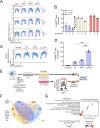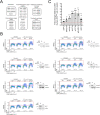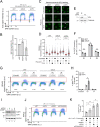A genome-wide screen identifies SCAI as a modulator of the UV-induced replicative stress response
- PMID: 36215310
- PMCID: PMC9584372
- DOI: 10.1371/journal.pbio.3001543
A genome-wide screen identifies SCAI as a modulator of the UV-induced replicative stress response
Abstract
Helix-destabilizing DNA lesions induced by environmental mutagens such as UV light cause genomic instability by strongly blocking the progression of DNA replication forks (RFs). At blocked RF, single-stranded DNA (ssDNA) accumulates and is rapidly bound by Replication Protein A (RPA) complexes. Such stretches of RPA-ssDNA constitute platforms for recruitment/activation of critical factors that promote DNA synthesis restart. However, during periods of severe replicative stress, RPA availability may become limiting due to inordinate sequestration of this multifunctional complex on ssDNA, thereby negatively impacting multiple vital RPA-dependent processes. Here, we performed a genome-wide screen to identify factors that restrict the accumulation of RPA-ssDNA during UV-induced replicative stress. While this approach revealed some expected "hits" acting in pathways such as nucleotide excision repair, translesion DNA synthesis, and the intra-S phase checkpoint, it also identified SCAI, whose role in the replicative stress response was previously unappreciated. Upon UV exposure, SCAI knock-down caused elevated accumulation of RPA-ssDNA during S phase, accompanied by reduced cell survival and compromised RF progression. These effects were independent of the previously reported role of SCAI in 53BP1-dependent DNA double-strand break repair. We also found that SCAI is recruited to UV-damaged chromatin and that its depletion promotes nascent DNA degradation at stalled RF. Finally, we (i) provide evidence that EXO1 is the major nuclease underlying ssDNA formation and DNA replication defects in SCAI knockout cells and, consistent with this, (ii) demonstrate that SCAI inhibits EXO1 activity on a ssDNA gap in vitro. Taken together, our data establish SCAI as a novel regulator of the UV-induced replicative stress response in human cells.
Conflict of interest statement
The authors have declared that no competing interests exist.
Figures







Similar articles
-
Replication Protein A Availability during DNA Replication Stress Is a Major Determinant of Cisplatin Resistance in Ovarian Cancer Cells.Cancer Res. 2018 Oct 1;78(19):5561-5573. doi: 10.1158/0008-5472.CAN-18-0618. Epub 2018 Aug 2. Cancer Res. 2018. PMID: 30072396
-
WASp modulates RPA function on single-stranded DNA in response to replication stress and DNA damage.Nat Commun. 2022 Jun 29;13(1):3743. doi: 10.1038/s41467-022-31415-z. Nat Commun. 2022. PMID: 35768435 Free PMC article.
-
Gap-filling and bypass at the replication fork are both active mechanisms for tolerance of low-dose ultraviolet-induced DNA damage in the human genome.DNA Repair (Amst). 2014 Feb;14:27-38. doi: 10.1016/j.dnarep.2013.12.005. Epub 2013 Dec 28. DNA Repair (Amst). 2014. PMID: 24380689
-
Chaperoning RPA during DNA metabolism.Curr Genet. 2019 Aug;65(4):857-864. doi: 10.1007/s00294-019-00945-3. Epub 2019 Feb 22. Curr Genet. 2019. PMID: 30796471 Review.
-
[Replication protein A as a major eukaryotic single-stranded DNA-binding protein and its role in DNA repair].Mol Biol (Mosk). 2016 Sep-Oct;50(5):735-750. doi: 10.7868/S0026898416030083. Mol Biol (Mosk). 2016. PMID: 27830676 Review. Russian.
Cited by
-
SMARCAL1 ubiquitylation controls its association with RPA-coated ssDNA and promotes replication fork stability.PLoS Biol. 2024 Mar 19;22(3):e3002552. doi: 10.1371/journal.pbio.3002552. eCollection 2024 Mar. PLoS Biol. 2024. PMID: 38502677 Free PMC article.
-
Synthetic lethal strategies for the development of cancer therapeutics.Nat Rev Clin Oncol. 2025 Jan;22(1):46-64. doi: 10.1038/s41571-024-00966-z. Epub 2024 Dec 3. Nat Rev Clin Oncol. 2025. PMID: 39627502 Review.
-
X-ray cross-complementing family: the bridge linking DNA damage repair and cancer.J Transl Med. 2023 Sep 7;21(1):602. doi: 10.1186/s12967-023-04447-2. J Transl Med. 2023. PMID: 37679817 Free PMC article. Review.
-
USP1-dependent nucleolytic expansion of PRIMPOL-generated nascent DNA strand discontinuities during replication stress.Nucleic Acids Res. 2024 Mar 21;52(5):2340-2354. doi: 10.1093/nar/gkad1237. Nucleic Acids Res. 2024. PMID: 38180818 Free PMC article.
-
Multi-step processing of replication stress-derived nascent strand DNA gaps by MRE11 and EXO1 nucleases.Nat Commun. 2023 Oct 7;14(1):6265. doi: 10.1038/s41467-023-42011-0. Nat Commun. 2023. PMID: 37805499 Free PMC article.
References
Publication types
MeSH terms
Substances
Grants and funding
LinkOut - more resources
Full Text Sources
Research Materials
Miscellaneous

